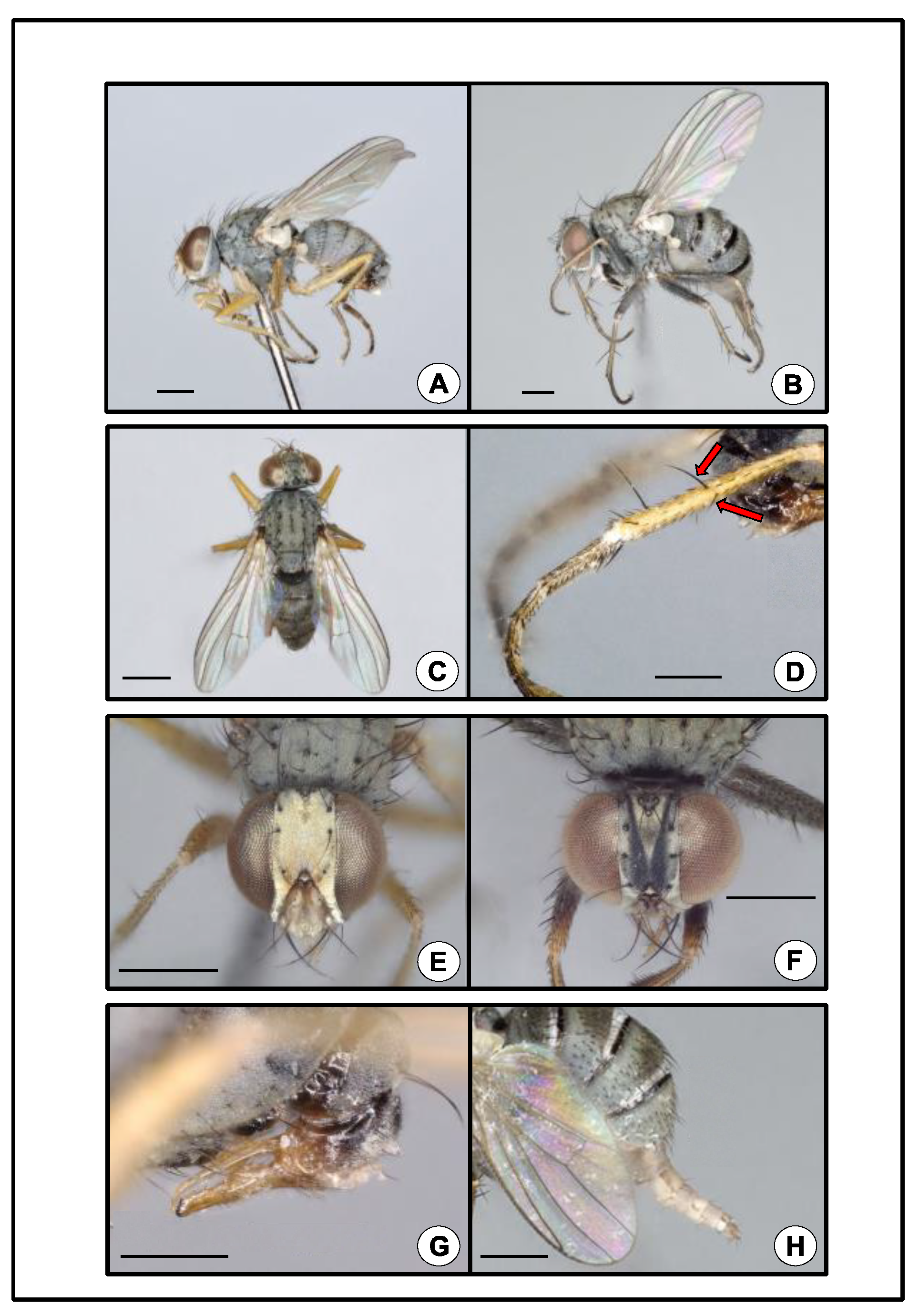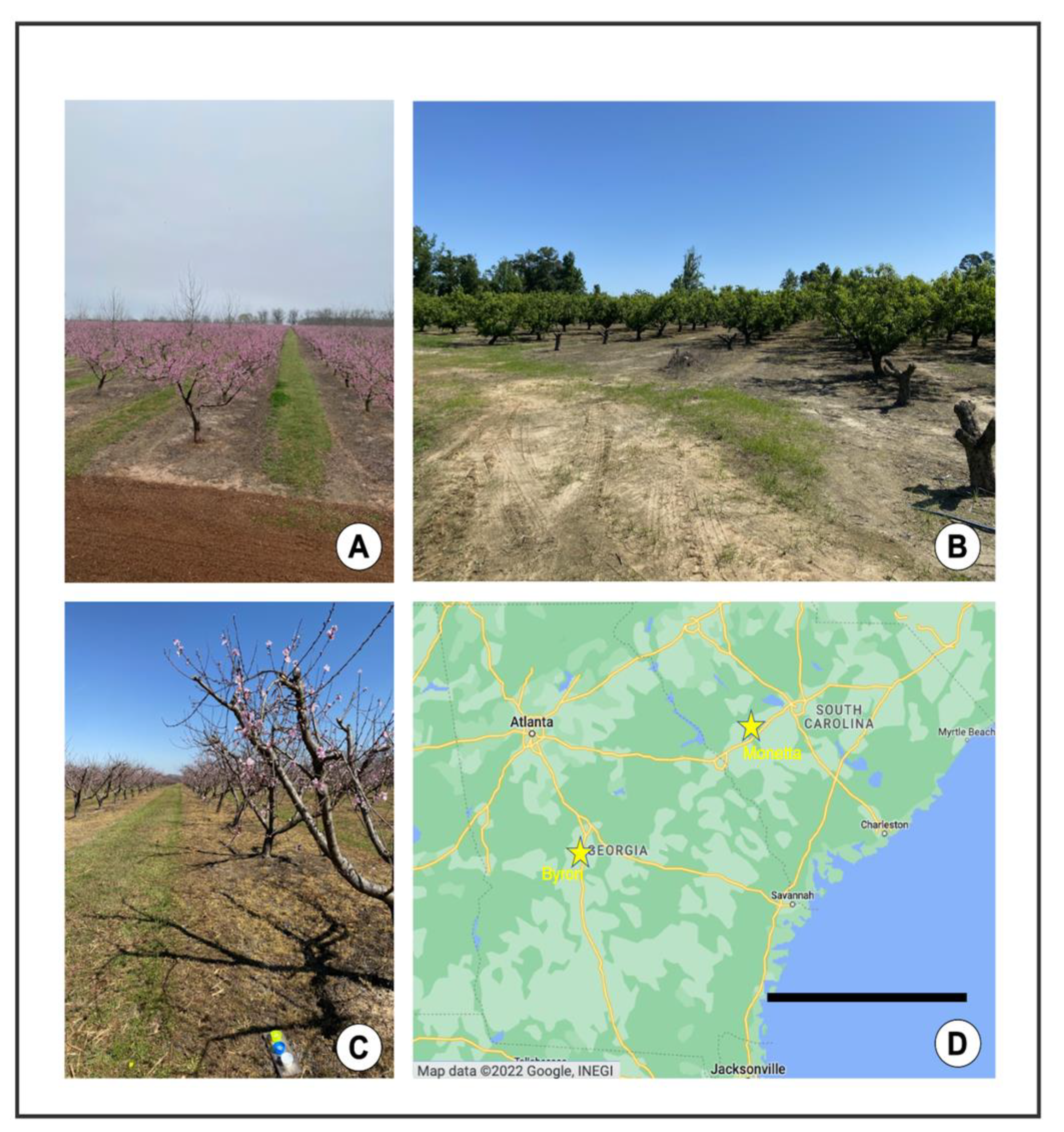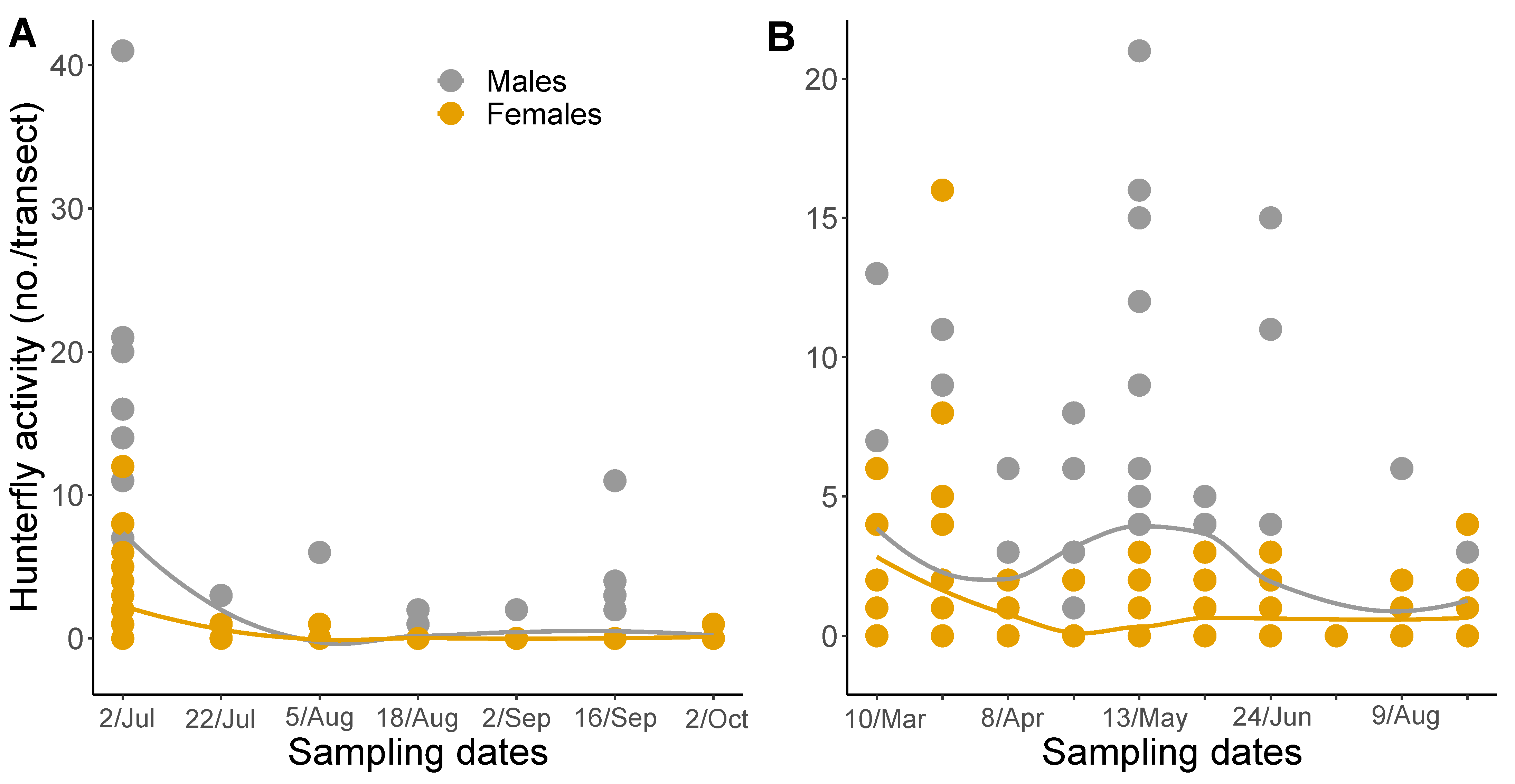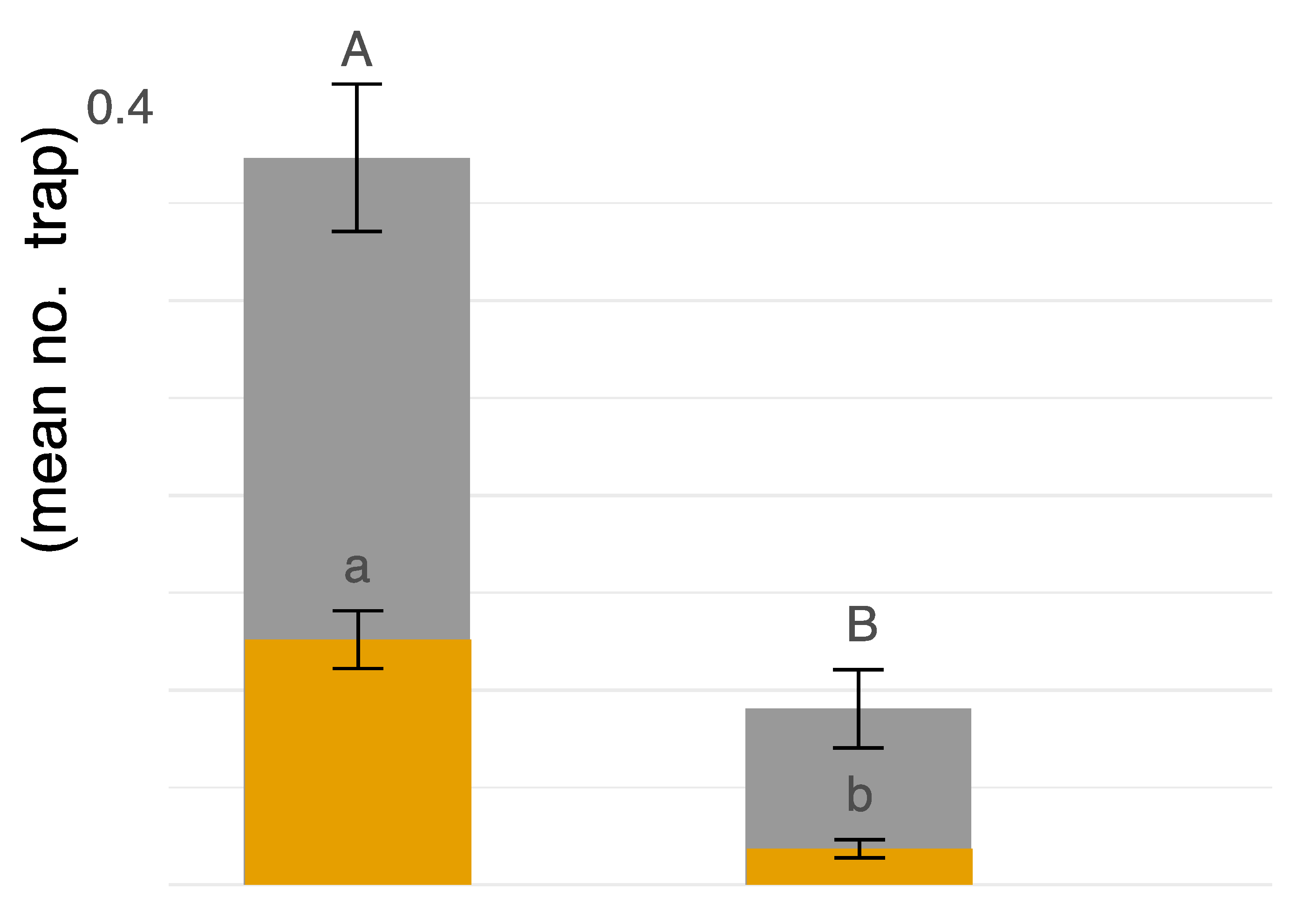First Documented Wild Population of the “Hunter Fly”, Coenosia attenuata Stein (Diptera: Muscidae) in North America
Abstract
Simple Summary
Abstract
1. Introduction
2. Materials and Methods
2.1. Field Sites
2.2. Sample Collection
2.3. Sample Processing
2.4. Statistical Analyses
3. Results
4. Discussion
5. Conclusions
Author Contributions
Funding
Data Availability Statement
Acknowledgments
Conflicts of Interest
References
- Seabra, S.G.; Brás, P.G.; Martins, J.; Martins, R.; Wyatt, N.; Shirazi, J.; Rebelo, M.T.; Franco, J.C.; Mateus, C.; Figueiredo, E. Phylogeographical patterns in Coenosia attenuata (Diptera: Muscidae): A widespread predator of insect species associated with greenhouse crops. Biol. J. Linn. Soc. 2015, 114, 308–326. [Google Scholar] [CrossRef]
- Ugine, T.A.; Sensenbach, E.J.; Sanderson, J.P.; Wraight, S.P. Biology and feeding requirements of larval hunter flies Coenosia attenuata (Diptera: Muscidae) reared on larvae of the fungus gnat Bradysia impatiens (Diptera: Sciaridae). J. Econ. Entomol. 2010, 103, 1149–1158. [Google Scholar] [CrossRef] [PubMed]
- Kühne, S. Open rearing of generalist predators: A strategy for improvement of biological pest control in greenhouses. Phytoparasitica 1998, 26, 277–281. [Google Scholar] [CrossRef]
- Pohl, D.; Kühne, S.; Karaca, İ.; Moll, E. Review of Coenosia attenuata Stein and its first record as a predator of important greenhouse pests in Turkey. Phytoparasitica 2012, 40, 63–68. [Google Scholar] [CrossRef]
- Zou, D.; Coudron, T.A.; Zhang, L.; Xu, W.; Xu, J.; Wang, M.; Xiao, X.; Wu, H. Effect of prey species and prey densities on the performance of adult Coenosia attenuata. Insects 2021, 12, 669. [Google Scholar] [CrossRef]
- Zou, D.; Coudron, T.A.; Xu, W.; Xu, J.; Wu, H. Performance of the tiger-fly Coenosia attenuata Stein reared on the alternative prey, Chironomus plumosus (L.) larvae in coir substrate. Phytoparasitica 2021, 49, 83–92. [Google Scholar] [CrossRef]
- Bautista-Martínez, N.; Illescas-Riquelme, C.P.; de Jesus García-Ávila, C. First report of “hunter-fly” Coenosia attenuata (Diptera: Muscidae) in Mexico. Fla. Entomol. 2017, 100, 174–175. [Google Scholar] [CrossRef]
- Tellez, M.D.M.; Tapia, G.; Gamez, M.; Cabello, T.; van Emden, H.F. Predation of Bradysia sp.(Diptera: Sciaridae), Liriomyza trifolii (Diptera: Agromyzidae) and Bemisia tabaci (Hemiptera: Aleyrodidae) by Coenosia attenuata (Diptera: Muscidae) in greenhouse crops. Eur. J. Entomol. 2009, 106, 199–204. [Google Scholar] [CrossRef]
- Martinez-Sanchez, A.; Marcos-Garcia, M.A.; Pont, A.C. Coenosia attenuata Stein, 1903 (Diptera, Muscidae) nueva especie para la fauna neotropical. Boll. Di Zool. Agrar. E Di Bachic. 2002, 34, 269–272. [Google Scholar]
- Pérez, M.M. Estudio de la morfología externa de los adultos de la mosca cazadora Coenosia attenuata Stein, 1903 (Diptera: Muscidae), y primer reporte para Colombia. Rev. De La Fac. De Cienc. Básicas 2006, 2, 68–87. [Google Scholar]
- Hernández-Ramírez, J.; Monge, M.P.; Casasola, L.E.; Solano, N.B.; Umaña, F.M. Presencia de la ‘mosca tigre’en Costa Rica. Actual. Fitosanit. 2008, 33, 1–4. [Google Scholar]
- Couri, M.S.; Salas, C. First record of Coenosia attenuata Stein (Diptera, Muscidae) from Chile, with biological notes. Rev. Bras. Entomol. 2010, 54, 144–145. [Google Scholar] [CrossRef]
- Solano-Rojas, Y.; Pont, A.; De Freitas, J.; Moros, G.; Goyo, Y. First record of Coenosia attenuata Stein, 1903 (Diptera: Muscidae) in Venezuela. In Anales de Biología; Servicio de Publicaciones de la Universidad de Murcia: Murcia, Spain, 2017; pp. 223–226. [Google Scholar]
- Orozco, J. DNA barcoding reveals the first record of Coenosia attenuata Stein (Diptera: Muscidae) in Honduras. CEIBA 2018, 55, 70–72. [Google Scholar] [CrossRef]
- Couri, M.S.; Sousa, V.R.; Lima, R.M.; Dias-Pini, N.S. The predator Coenosia attenuata Stein (Diptera, Muscidae) on cultivated plants from Brazil. An. Da Acad. Bras. De Ciências 2018, 90, 179–183. [Google Scholar] [CrossRef]
- Giambiasi, M.; Rodríguez, A.; Arruabarrena, A.; Buenahora, J. First report of Coenosia attenuata (Stein, 1903) (Diptera, Muscidae) in Uruguay, confirmed by DNA barcode sequences. Check List 2020, 16, 749–752. [Google Scholar] [CrossRef]
- Hoebeke, E.R.; Sensenbach, E.J.; Sanderson, J.P.; Wraight, S.P. First report of Coenosia attenuata Stein (Diptera: Muscidae), an Old Worldhunter fly’in North America. Proc.-Entomol. Soc. Wash. 2003, 105, 769. [Google Scholar]
- Konrad, C.E.; Fuhrmann, C.M. Climate of the southeast USA: Past, present, and future. In Climate of the Southeast United States; Springer: Berlin/Heidelberg, Germany, 2013; pp. 8–42. [Google Scholar]
- Blaauw, B.; Brannen, P.; Lockwood, D.; Schnabel, G.; Ritchie, D. 2022 Southeastern peach, nectarie, and plum pest management and culture guide. UGA Coop. Ext. Bull. 2022, 1171, 1–78. [Google Scholar]
- Google. Google Maps. Map Data © 2022 Google, INEGI. Available online: https://www.google.com/maps/@32.8502955,-81.4519247,6.98z (accessed on 6 July 2022).
- Campbell, J.W.; Hanula, J. Efficiency of Malaise traps and colored pan traps for collecting flower visiting insects from three forested ecosystems. J. Insect Conserv. 2007, 11, 399–408. [Google Scholar] [CrossRef]
- Schlueter, M.A.; Stewart, N.G. Native bee (Hymenoptera: Apoidea) abundance and diversity in north Georgia apple orchards throughout the 2010 growing season (March to October). Southeast. Nat. 2015, 14, 721–739. [Google Scholar] [CrossRef]
- Hennig, W.; Lindner, E.E. Muscidae Die Flieg. Der Palaearktischen Reg. 1964, 63, 481–528. [Google Scholar]
- Folmer, O.; Black, M.; Hoeh, W.; Lutz, R.; Vrijenhoek, R. DNA primers for amplification of mitochondrial cytochrome c oxidase subunit I from diverse metazoan invertebrates. Mol. Mar. Biol. Biotechnol. 1994, 3, 294–299. [Google Scholar] [PubMed]
- Cutler, G.C.; Gariepy, T.D.; De Silva, E.C.A.; Hillier, N.K. High rates of parasitism of blueberry spanworm (Lepidoptera: Geometridae) by Ichneumonidae and Tachinidae in commercial lowbush blueberry fields. J. Pest Sci. 2015, 88, 219–223. [Google Scholar] [CrossRef]
- Cicero, J.M.; Adair, M.M.; Adair, R.C.; Hunter, W.B.; Avery, P.B.; Mizell, R.F. Predatory behavior of long-legged flies (Diptera: Dolichopodidae) and their potential negative effects on the parasitoid biological control agent of the Asian citrus psyllid (Hemiptera: Liviidae). Fla. Entomol. 2017, 100, 485–487. [Google Scholar] [CrossRef]
- Pons, L. Greenhouse Pests Beware. Agric. Res. 2005, 53, 7. [Google Scholar]
- Mateus, C. Bioecology and behaviour of Coenosia attenuata in greenhouse vegetable crops in the Oeste region, Portugal. Bull. Insectol 2012, 65, 257–263. [Google Scholar]
- Martinez, M.; Cocquempot, C. La mouche Coenosia attenuata, un nouvel auxiliaire prometteur en culture protégée. PHM Rev. Hortic. 2000, 414, 50–52. [Google Scholar]
- Sensenbach, E.J. Coenosia Attenuata Stein (Diptera: Muscidae): A Predatory Fly in North American Greenhouses; Cornell University, August: Ithaca, NY, USA, 2004. [Google Scholar]
- Sensenbach, E.; Wraight, S.; Sanderson, J. Biology and predatory feeding behavior of larvae of the hunter fly Coenosia attenuata. IOBC/Wprs Bull. 2005, 28, 229–232. [Google Scholar]
- Zou, D.; Coudron, T.A.; Xu, W.; Gu, X.; Wu, H. Development of immature tiger-fly Coenosia attenuata (Stein) reared on larvae of the fungus gnat Bradysia impatiens (Johannsen) in coir substrate. Phytoparasitica 2017, 45, 75–84. [Google Scholar] [CrossRef]
- Kühne, S. Räuberische Fliegen der Gattung Coenosia Meigen, 1826 (Diptera: Muscidae) und die Möglichkeit ihres Einsatzes bei der Biologischen Schädlingsbekämpfung; Ampyx-Verlag: Halle/Saale, Germany, 2000. [Google Scholar]
- Pohl, D.; Uygur, F.; Sauerborn, J. Note: Fluctuations in population of the first recorded predatory fly Coenosia attenuata in cotton fields in Turkey. Phytoparasitica 2003, 31, 446–449. [Google Scholar] [CrossRef]
- Drummond, F.A.; Groden, E.; Haynes, D.; Edens, T.C. Some Aspects of the Biology of a Predaceous Anthomyiid Fly, Coenosia tigrina. Great Lakes Entomol. 1989, 22, 2. [Google Scholar]
- Ivković, M.; Pont, A.C. Long-time emergence patterns of Limnophora species (Diptera, Muscidae) in specific karst habitats: Tufa barriers. Limnologica 2016, 61, 29–35. [Google Scholar] [CrossRef]
- Martins, J.; Mateus, C.; Ramos, A.C.; Figueiredo, E. An optimized method for mass rearing the tiger-fly, Coenosia attenuata (Diptera: Muscidae). Eur. J. Entomol. 2015, 112, 470–476. [Google Scholar] [CrossRef]




Publisher’s Note: MDPI stays neutral with regard to jurisdictional claims in published maps and institutional affiliations. |
© 2022 by the authors. Licensee MDPI, Basel, Switzerland. This article is an open access article distributed under the terms and conditions of the Creative Commons Attribution (CC BY) license (https://creativecommons.org/licenses/by/4.0/).
Share and Cite
Kaldor, A.D.; McHugh, J.V.; Schmidt, J.M.; Luo, X.; Gariepy, T.D.; Blaauw, B.R. First Documented Wild Population of the “Hunter Fly”, Coenosia attenuata Stein (Diptera: Muscidae) in North America. Insects 2022, 13, 970. https://doi.org/10.3390/insects13110970
Kaldor AD, McHugh JV, Schmidt JM, Luo X, Gariepy TD, Blaauw BR. First Documented Wild Population of the “Hunter Fly”, Coenosia attenuata Stein (Diptera: Muscidae) in North America. Insects. 2022; 13(11):970. https://doi.org/10.3390/insects13110970
Chicago/Turabian StyleKaldor, Amos D., Joseph V. McHugh, Jason M. Schmidt, Xuelin Luo, Tara D. Gariepy, and Brett R. Blaauw. 2022. "First Documented Wild Population of the “Hunter Fly”, Coenosia attenuata Stein (Diptera: Muscidae) in North America" Insects 13, no. 11: 970. https://doi.org/10.3390/insects13110970
APA StyleKaldor, A. D., McHugh, J. V., Schmidt, J. M., Luo, X., Gariepy, T. D., & Blaauw, B. R. (2022). First Documented Wild Population of the “Hunter Fly”, Coenosia attenuata Stein (Diptera: Muscidae) in North America. Insects, 13(11), 970. https://doi.org/10.3390/insects13110970



